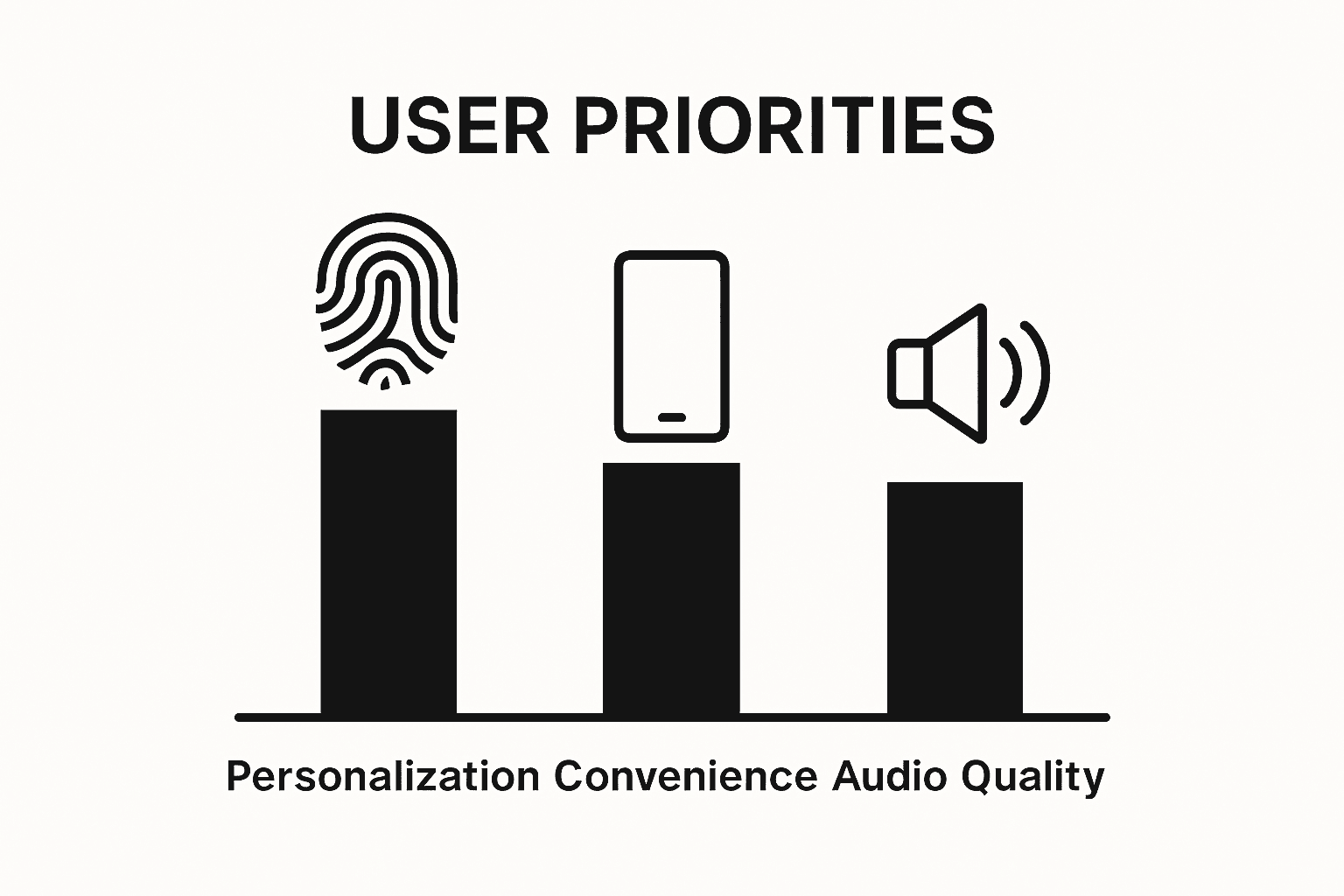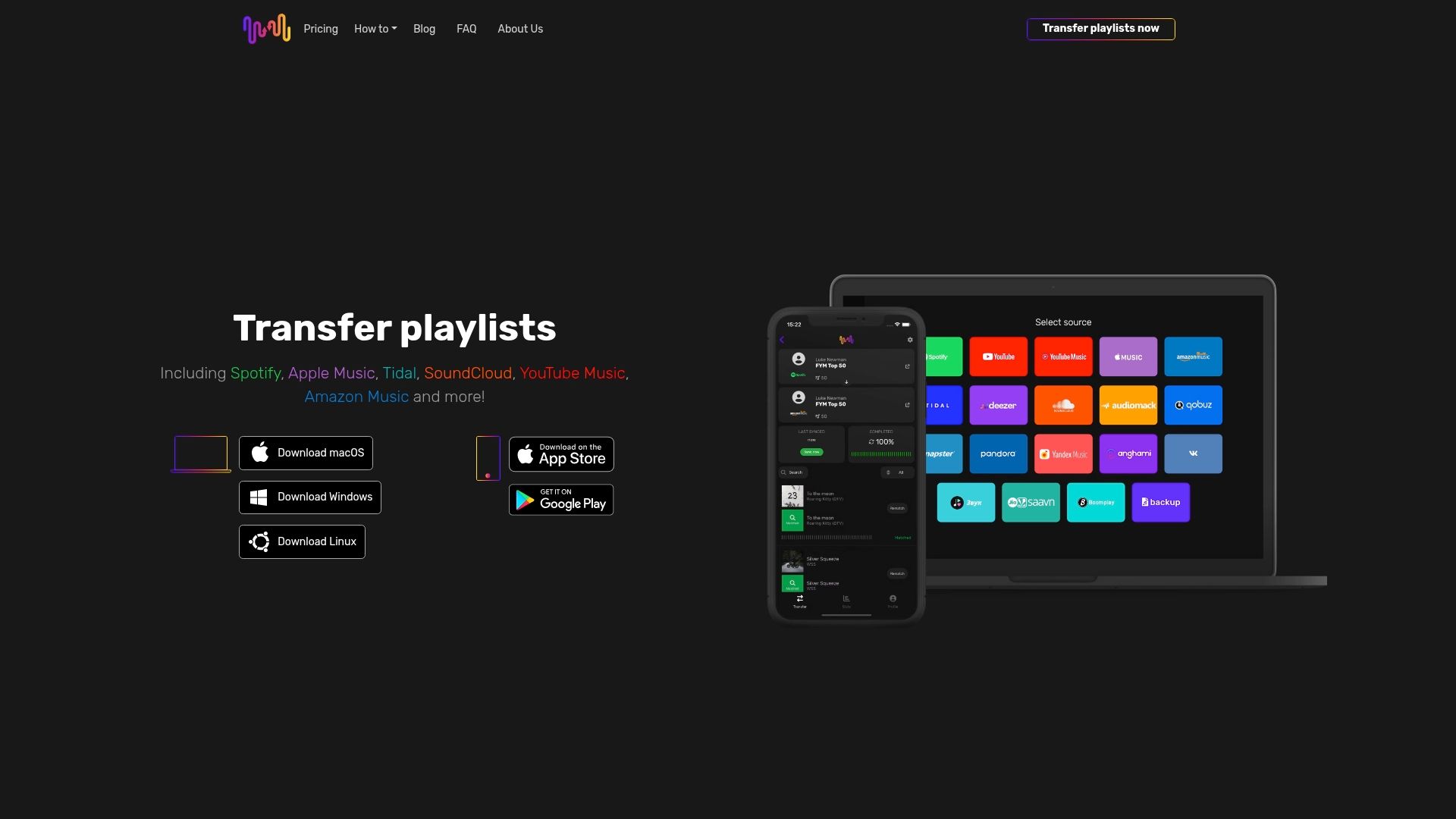Music streaming may seem all about convenience, but the real story goes deeper. Over 80 percent of users say smart recommendations and seamless device sync matter more than just playing songs. You might think most people crave endless song catalogs, but it turns out what they really want is a platform that truly understands their taste and feels as personal as their favorite playlist.
Quick Summary
| Takeaway | Explanation |
|---|---|
| Personalization enhances user engagement. | Users expect platforms to offer tailored music recommendations that reflect their individual tastes and preferences for deepened engagement. |
| Convenience drives user satisfaction. | Seamless access across devices and key features like offline listening are essential for satisfying today's music streaming users. |
| High audio quality is a priority. | Users are increasingly drawn to platforms that offer superior audio fidelity, contributing to a richer music experience. |
| User feedback shapes platform evolution. | Streaming services benefit from actively integrating user insights to enhance features and adapt to changing listening habits. |
| Demographics influence music preferences. | Different age groups and cultural backgrounds significantly affect how users interact with music platforms and their content needs. |
What are the core needs of music streaming users?
Music streaming users have diverse and complex requirements that extend far beyond simply playing songs. Research analyzing consumer perceptions reveals several fundamental needs that shape their digital music experience.
Personalization and Discovery
At the core of music streaming user needs is the desire for personalized musical experiences. Users want platforms that understand their unique taste preferences and help them discover new music seamlessly. Modern listeners expect intelligent recommendation systems that go beyond generic suggestions, diving deep into their listening history and intrinsic musical preferences.
The ability to explore unfamiliar musical territories while maintaining a sense of personal connection is crucial. Users seek platforms that can introduce them to artists and genres that align with their existing musical tastes, creating a balance between familiarity and novelty. This means recommendation algorithms must be sophisticated enough to analyze not just listening history, but also consider musical attributes like tempo, mood, and instrumental characteristics.
Convenience and Accessibility
Convenience remains a paramount concern for music streaming users. They demand platforms that offer seamless cross-device synchronization, allowing uninterrupted music experiences across smartphones, tablets, computers, and smart speakers. The modern listener wants their music library accessible anywhere, anytime, without complicated transfer processes.
Key accessibility features include:
- Offline listening capabilities
- Smooth playlist management
- Quick music discovery tools
- Intuitive user interfaces
Quality and Functionality
Beyond basic playback, users prioritize streaming services that offer high-quality audio and comprehensive functionality. This includes lossless audio options, detailed artist information, lyrics integration, and social sharing capabilities. Music enthusiasts want platforms that provide rich, immersive experiences that go beyond simple track playback.

Interested in easily transferring your music between platforms? Check out our playlist migration guide to simplify your streaming experience.
Why understanding user needs enhances music engagement?
Research in music streaming interactions demonstrates that comprehending user needs is critical for creating meaningful digital music experiences. Understanding these needs transforms passive listening into active, personalized engagement.
Psychological Connection and Musical Identity
Music is deeply personal, serving as an extension of individual identity and emotional expression. When streaming platforms recognize this fundamental psychological connection, they create environments that resonate with users on a profound level. By understanding listeners' unique preferences, platforms can craft experiences that feel intrinsically tailored to each user's musical journey.
This personalization goes beyond algorithmic recommendations. It involves creating spaces where users feel genuinely understood, where their musical exploration is supported and celebrated. The psychological validation of having a platform that "gets" your musical taste can significantly increase user satisfaction and long-term platform loyalty.
Enhancing User Experience Through Intelligent Design
Intelligent design driven by user needs transforms music streaming from a transactional service to an immersive experience. Platforms that invest in understanding user behaviors can develop features that anticipate listener preferences, creating proactive musical environments.
Key elements of enhanced user experience include:
- Contextual music recommendations
- Adaptive playlist generation
- Mood-based music selection
- Seamless cross-platform synchronization
Data-Driven Personalization Strategies
Comprehensive user needs analysis allows streaming services to implement sophisticated personalization strategies. By examining listening patterns, emotional responses, and contextual music consumption, platforms can create increasingly accurate and nuanced recommendation systems.
Want to explore how seamless music migration supports your personalized listening experience? Learn about our playlist transfer capabilities and unlock new ways to enjoy your music collection.
How do different user demographics influence streaming preferences?
Scientific research on music listening behaviors reveals that demographic factors profoundly shape music streaming experiences, transforming how different age groups, cultures, and social segments interact with digital music platforms.
Age-Related Musical Preferences
Age represents a critical factor in determining music streaming behaviors and preferences. Younger listeners typically demonstrate more dynamic and experimental musical consumption patterns, characterized by frequent playlist updates, genre exploration, and higher engagement with emerging artists. Teenagers and young adults often view music as a core component of personal identity, using streaming platforms to discover and share their evolving musical tastes.
In contrast, older demographics tend to exhibit more consistent listening habits. Middle-aged and senior users frequently prioritize familiarity, gravitating towards established artists and genres that resonate with their historical musical experiences.
Their streaming interactions often emphasize quality, depth, and nostalgic connections rather than constant novelty.
To clarify how user demographics affect music streaming preferences, the following table outlines the distinct characteristics and priorities of different user groups discussed in the article.
| Demographic Factor | Characteristics | Music Streaming Preferences |
|---|---|---|
| Age: Teenagers/Young Adults | Dynamic, experimental, highly engaged in musical identity | Frequent playlist updates, genre exploration, discovery focus |
| Age: Middle-aged/Seniors | Consistent, nostalgic, preference for established artists | Favor familiarity, quality, depth, historical connections |
| Cultural/Geographic | Influenced by local traditions, region-specific trends | Language, genre popularity, local norms |
| Socioeconomic Status | Varied access to technology and financial resources | Premium service use, focus on advanced features, device compatibility |
Cultural and Geographic Influences
Geographic and cultural backgrounds significantly impact streaming preferences, creating nuanced musical ecosystems. Different regions develop unique listening patterns influenced by local musical traditions, social contexts, and cultural music consumption norms.
Key demographic streaming variations include:
- Language preferences in music selection
- Regional genre popularity
- Cultural music consumption rhythms
- Technological access and infrastructure differences
Socioeconomic and Technological Access
Socioeconomic factors play a substantial role in streaming preferences, with technological access and disposable income determining users' musical interaction capabilities. Higher-income demographics often engage with premium streaming services offering advanced features like high-fidelity audio, comprehensive libraries, and sophisticated recommendation algorithms.
Interested in understanding how different music platforms cater to diverse user needs? Explore our playlist transfer options and discover seamless music migration across various streaming environments.
What features do users prioritize in streaming platforms?
University research on digital music consumption reveals that modern music streaming users seek comprehensive, intelligent platforms that transcend traditional audio playback. Understanding these priorities helps platforms design more engaging and user-centric experiences.
Personalization and Intelligent Recommendations
Users prioritize intelligent recommendation systems that feel like personal music curators. Beyond simple genre matching, listeners want platforms that understand their nuanced musical preferences, emotional states, and contextual listening habits. This means algorithms capable of suggesting tracks that not only align with existing taste but also introduce thoughtful, unexpected musical discoveries.
The most valued recommendation features include mood-based playlists, activity-driven music selections, and suggestions that demonstrate a deep understanding of individual musical complexity. Users appreciate when platforms feel like they genuinely comprehend their unique musical identity, creating a sense of personal connection beyond algorithmic calculations.
Technological Convenience and Accessibility
Seamless technological integration represents another critical user priority. Modern listeners demand platforms that provide frictionless music experiences across multiple devices and environments. This includes robust offline listening capabilities, instant synchronization across smartphones, computers, and smart home devices, and minimal interruption during music playback.
Key technological convenience features include:
- Cross-device playlist synchronization
- Minimal buffering and high-quality streaming
- Intuitive user interface design
- Robust offline listening modes
Audio Quality and Additional Content
Discerning users increasingly prioritize platforms offering superior audio quality and rich supplementary content. High-fidelity audio options, comprehensive artist information, integrated lyrics, and social sharing capabilities transform music streaming from a passive listening experience into an interactive musical journey.

Interested in exploring how different streaming platforms can meet your musical needs? Discover our playlist transfer solutions and unlock seamless music migration across various services.
How does user feedback shape the future of music streaming services?
Research exploring collaborative design in digital music platforms reveals that user feedback represents a critical mechanism for evolving music streaming technologies, transforming platforms from static services to dynamic, user-driven ecosystems.
Continuous Platform Evolution
User feedback functions as a sophisticated diagnostic tool, enabling streaming services to continuously refine their technological offerings. By systematically analyzing user comments, interaction patterns, and expressed preferences, platforms can identify nuanced improvements that extend far beyond traditional product development approaches.
This dynamic feedback loop allows services to quickly adapt to changing musical consumption trends, technological capabilities, and user expectations. Platforms that successfully integrate user insights can create more responsive, intuitive experiences that feel personally tailored to individual listener needs.
Recommendation System Optimization
User-generated feedback plays a pivotal role in enhancing recommendation algorithms. By understanding detailed user reactions to suggested tracks, platforms can develop increasingly sophisticated musical mapping techniques that transcend basic genre categorizations.
Key feedback-driven optimization strategies include:
- Sentiment analysis of user comments
- Tracking skip rates and listening duration
- Monitoring playlist creation patterns
- Analyzing cross-genre listening behaviors
Community-Driven Innovation
Modern music streaming services are transforming from technology providers to collaborative platforms where users actively contribute to service development. User feedback becomes a critical innovation driver, helping platforms identify emerging musical trends, technological expectations, and user experience improvements.
This community-driven approach democratizes platform development, allowing listeners to become active participants in shaping future music streaming experiences. By valuing and integrating user perspectives, services can create more engaging, personalized musical ecosystems.
Interested in exploring how music platforms adapt to user needs? Check out our playlist transfer solutions and experience seamless music migration across different services.
Transform Your Music Streaming Experience Without Losing Your Playlists
Personalization and seamless access are at the heart of what music streaming users truly want. This article sheds light on the frustration many listeners face when changing platforms — having to rebuild playlists, lose personal recommendations, and disrupt years of carefully curated music. Your time is better spent discovering new music, not reconstructing your collection from scratch. Free Your Music understands these pain points and is built to solve them.

Ready to keep your personalized music journey intact when switching services? With FreeYourMusic.com, you can move your playlists effortlessly between major platforms. Avoid losing your playlists or the unique discovery pathways that reflect your taste. Start your transfer today and keep your music world uninterrupted. Take control of your listening habits immediately with FreeYourMusic.com and see how easy music migration can be. For more details on the full platform, visit our homepage and begin a smooth transition now.
Frequently Asked Questions
What are the key needs of music streaming users?
Music streaming users primarily seek personalization, convenience, quality, and functionality. They desire platforms that provide tailored music recommendations, easy accessibility across devices, high-quality audio, and additional features like lyrics integration and social sharing capabilities.
How does user feedback influence music streaming services?
User feedback plays a vital role in shaping the future of music streaming services by allowing platforms to continuously refine their offerings, optimize recommendation systems, and innovate based on community-driven insights. This helps create services that better meet user preferences and trends.
Why is personalization important in music streaming?
Personalization enhances the user experience by providing tailored musical recommendations that resonate with individual taste preferences. When users feel understood by the platform, it can significantly improve their satisfaction and loyalty to the service.
What demographic factors impact music streaming preferences?
Demographic factors such as age, cultural background, and socioeconomic status influence music streaming preferences, including listening habits, genre choices, and the importance placed on audio quality. Younger listeners tend to explore new music dynamically, while older users often prefer familiar artists and genres.






